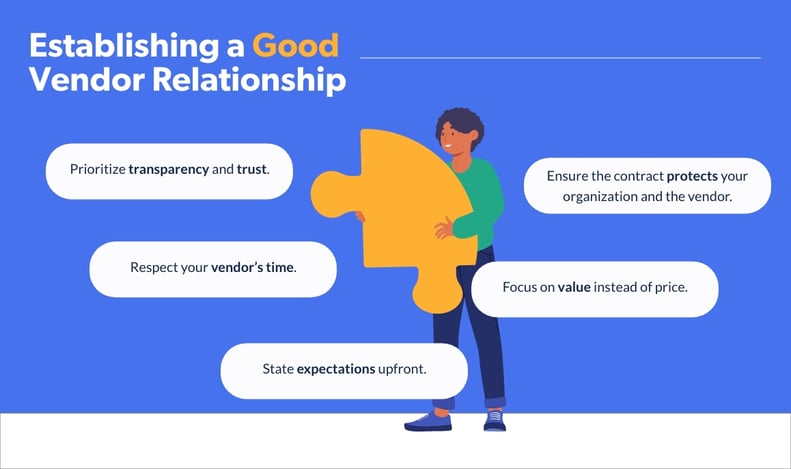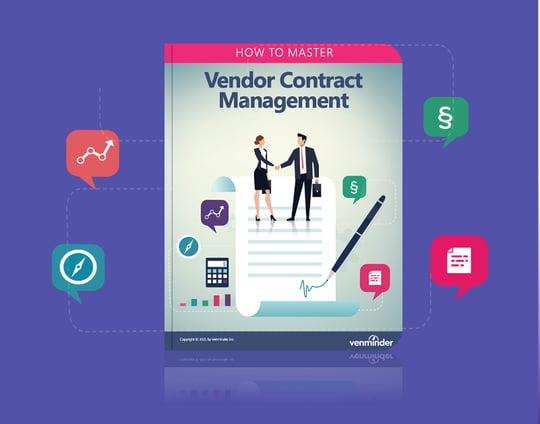Outsourcing to a vendor typically creates tangible benefits for an organization and should also create benefits for the vendor. The best business relationships are those that provide gains for both parties. Unfortunately, some organizations maintain that they should have the upper hand over their vendors at all times.
Poor vendor management usually backfires, whether the organization is constantly squeezing the vendor for the lowest possible price or expecting the vendor to absorb all the risk. There is no substitute for a healthy vendor relationship where both parties are respected and rewarded. The ideal vendor relationship operates from the perspective of win-win.
Let's take a look at establishing, maintaining and benefiting from good vendor relationships.
Establishing a Good Vendor Relationship
As the old saying goes, you never get a second chance at a first impression. When you make the effort to put your best foot forward, you’ll set yourself up for a strong vendor relationship.

Consider the following tips to build a good foundation:
- Prioritize transparency and trust. This means providing the right information for a vendor to provide the best solution and disclosing any gaps or issues in your organization that might prevent a vendor from delivering the right product or service at the quoted price or typical delivery method.
- Respect your vendor's time. Failure to attend scheduled meetings or promptly respond to a vendor's question sends the message that the vendor's time isn’t as important as yours, which creates unnecessary friction and is no way to start a relationship.
- State expectations upfront. Your organization's requirements for vendors should be discussed early and often. Initially, conversations tend to be all about the product or service desired. However, explaining basic processes and expectations, such as submitting a questionnaire and documentation during due diligence and annually after that, removes any surprises and sets the stage for a smooth onboarding and relationship.
- Focus on value instead of price. There’s an old saying, "You can have high quality, speedy delivery or low cost; pick two." You must be mindful that the vendor is in business to make money, not subsidize their customers. Understand that the total value of a product and service goes beyond the price point. Poor quality products and services can create delays or rework and might damage your reputation. Both situations impact your bottom line. Likewise, paying for the quality and speed you require will benefit your organization as well.
- Ensure the contract protects your organization and the vendor. Asserting both parties' rights, roles and responsibilities within the contract demonstrates fair-mindedness and is a good business practice. Presentation of a one-sided contract not only erodes trust but can be harmful to the negotiation and make the other party less likely to compromise.
Improving or Maintaining a Vendor Relationship
Remember that a good relationship takes work and you can’t expect for everything to progress perfectly just because you had a smooth onboarding process. Whether you want to make improvements with a difficult vendor relationship or simply want to maintain a good one, there are things to consider.
Keep these three tips in mind:
- Always be professional. Many vendor managers inherit relationships. Some good and some bad. Suppose you have recently assumed a relationship with a "troublesome" vendor, and things have been strained between your organization and the vendor for some time. In that case, it’s best to understand the facts as they’re documented and approach the vendor with professionalism and neutrality. Introduce yourself and invite the vendor to a conversation to educate you on the relationship and provide suggestions for improvement. Let them know you’re there to see if there are ways to reshape the relationship for the benefit of all. If it turns out that the vendor is just a “bad apple,” you can still be proud of how you represented your organization.
- Set clear boundaries. It’s not unusual to become well acquainted with your vendor, especially after working together for a long time or on a difficult project. However, be mindful that you don't fall into the "friendor" trap. That isn’t to say you won't occasionally form friendships with your vendors, but make sure that there is a clear line between business and friendship. For example, be wary of accepting expensive gifts or entertainment from vendors as it can be construed as buying your influence or favor and may be in violation of your organization’s policy. As a best practice, limit business-related conversations and decisions to business hours and locations. If you and your vendor friend decide to get together outside of work, discourage using company credit cards to pay for meals, drinks or entertainment. Share the cost or take turns paying using personal funds.
- Be honest and fair. If the vendor has great performance, let them know or send a note of thanks to their manager. Perhaps you can consider them for additional opportunities, more volume or a strategic partnership. Now suppose the vendor has poor performance, such as unmet SLA's. In this case, you must ask them to identify the root cause, create a remediation plan and confirm their commitments to improve. When bad news is delivered directly and respectfully, without excess negativity, there is a good chance the vendor will respond professionally and set about fixing the issue.
Benefits of a Win-Win Relationship
A great vendor relationship can yield great benefits beyond the products and services they provide to your organization. Many vendors value customer loyalty and often find ways to show it through discounts, free product testing and more. One benefit that vendors often provide to their best customers is free "consulting." As your vendor is an industry insider, they may have insight, reports or other information not available to you directly that might help you make better strategic decisions.
In summary, when you foster positive and productive relationships with your vendors, it’s easy to spot all the benefits those relationships can provide.
Likewise, when vendors are casually disrespected or treated as disposable, replaceable and purely transactional, they’ll limit their value to only what is required by contract. A good rule of thumb in any vendor relationship is to look beyond the transaction and see if you can identify the benefit for both parties. If you can, you’re doing it right.












